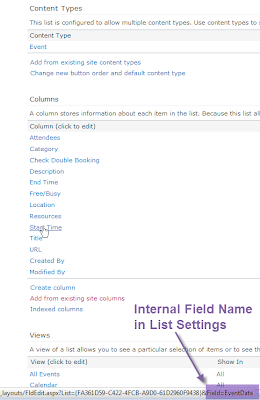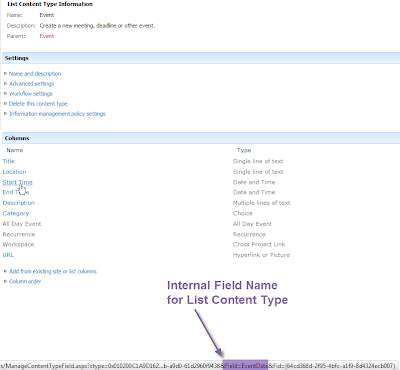The Content Query Web Part is by far one of the most versatile out-of-the-box web parts that SharePoint 2010 provides for allowing the user to aggregate data from a single list or multiple lists within a site and subsites or even site collection wide.
When aggregating data though from an Calendar list type and using a custom XSL ItemStyle, you may have found some oddities with the list columns “Start Time” and “Description” if you desired to display either of these two columns in your web part.
If you would like to skip directly to the solution, you can do so here:
DISCOVERY
If you analyze the column architecture of the list, you will notice that the list uses the Event Content Type and if you were to look the internal names for “Start Time” and “Description” columns, you would find:
 |
| Internal Field Name in List Settings |
Table 1 List Level Content Type Column Names:
| Column Name | Display Name | Internal Name |
| Start Time | Start Time | EventDate |
| Description | Description | Description |
 |
| Internal Field Name for List Content Type |
| Column Name | Display Name | Internal Name |
| Start Time | Start Time | StartDate |
| Description | Description | Comments |
1. The first step is to ensure your custom .webpart file includes a reference in the “CommonViewFields” property to both of the internal column names for each of the “Start Time” and “Description” columns. For the example in this solution, we will focus on the “Start Time” column, but the same actions can be applied on the “Description” column as well.
 |
| CommonViewFields Property in .webpart fille. |
For example, if you set the scope of your CQWP to aggregate all of the events from the entire site collection, the CQWP will return your “Start Time” value in a column named “StartDate” (Table 2 above) and therefore the “EventDate” column name will be blank.
If the scope is set directly on a list instead, then the “Start Time” value will be returned in a column named “EventDate” and the “StartDate” column will be blank.
<xsl:variable name="CalendarStartDate">
<xsl:choose>
<xsl:when test="@StartDate != ''">
<xsl:value-of select="@StartDate"/>
</xsl:when>
<xsl:when test="@EventDate != ''">
<xsl:value-of select="@EventDate"/>
</xsl:when>
</xsl:choose>
</xsl:variable>
The XSL variable starts with the Site Content Type Event column name “StartDate” (Table 2 above) and checks to see if it has any value. If there is a value in this column, that value is returned.
The same test is then applied checking for a value in the List Level Content Type Event column name “EventDate”. If there is a value in this column, then value is returned.
Because we know that dependent on the scope of the CQWP, only one of these column names are used at a time.
NOTE: If you are concerned that both “<xsl:when>” statements will return true, you could replace one of the “<xsl:when>” statements with an “<xsl:otherwise>” statement and know for sure only one will ever be returned. Based on my tests though, I felt this was not necessary. Feel free to let me know if you encounter a scenario that would warrant the use of the “<xsl:otherwise>” instead of using the two “<xsl:when>” statements.
– You may have experienced that when you implement the solution in this blog post, you begin experiencing errors when you try to edit your web part and modify the web part properties on a page.
There is a solution and I have documented it in a separate blog post entitled “Error when editing the (CQWP) Content Query web part properties that is scoped on an Events / Calendar list in SharePoint 2010“.





